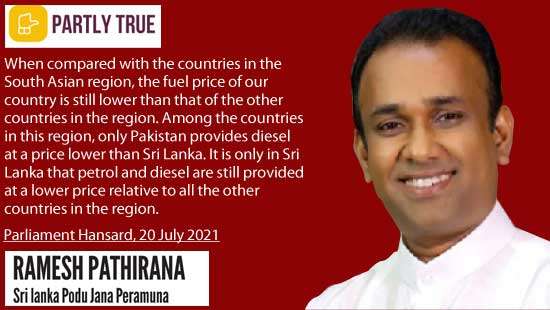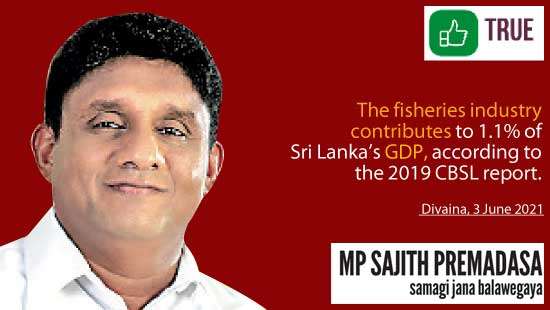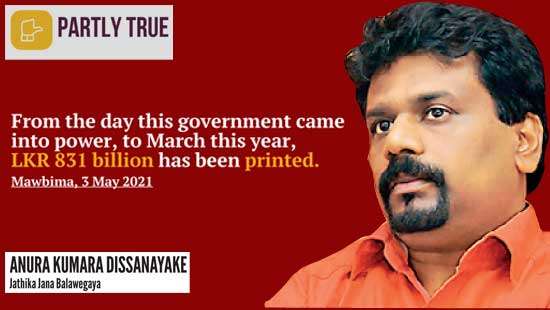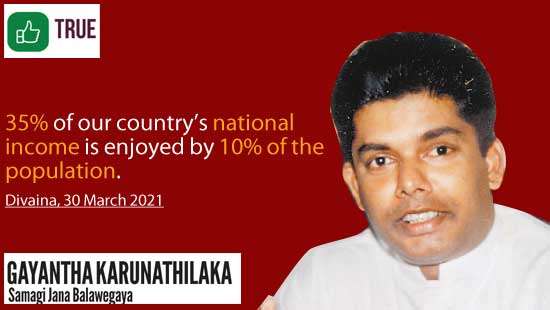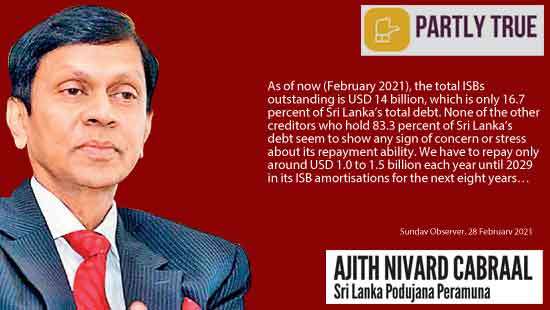Fact Check
Former State Minister Cabraal misrepresents Covid-19 expenditure
14 Oct 2021
 0
0
The former state minister’s statement provides a breakdown of social and related expenditures by government, and as reported attributes LKR 700 billion to the costs of control and relief activities due to Covid-19. (Headline in the Daily News: Rs 7
MP Wickramaratne generates interest on Sri Lanka’s record cost of interest
30 Sep 2021
 1
1
In his statement, the MP states that (1) 70% of government revenue is spent on interest on loan repayments, and (2) Lebanon is the only country in the world to pay higher interest than Sri Lanka as a percentage of national revenue. To evaluate this claim, FactCheck.lk consulted the Central Bank of Sri Lanka (CBSL) Annual Reports and the World Bank World Development Indic
UNP Deputy Leader Wijewardena mostly wrong on Covid-19 death analysis
23 Sep 2021
 1
1
The former MP claims that (a) 10 Covid-19 patients die every hour in Sri Lanka, (b) the ratio of Covid-19 death to cases in Sri Lanka is 1.5%, and (c) Sri Lanka reports the highest daily Covid-19 death rate in the Asian region at the time of his statement (i.e., 11 August).
Opposition Leader Premadasa estimates bitter decline in sugar tax revenue
10 Sep 2021
 0
0
In Sri Lanka, the phrase “sugar scam” refers to the scandal surrounding the sudden large reduction in the Special Commodity Levy (SCL) on sugar imports, which took place on 13 October 2020. The SCL on sugar was reduced by 99.5%
State Minister Godahewa mostly true on relatively high population dependence on agriculture sector
19 Aug 2021
 1
1
In his statement, the state minister claimed that the population percentage dependent on agriculture is over 30%, while the contribution to GDP is less than 10%. His figures indicate that the population percentage dependent on agricultur
MP Ranawaka notes a hidden aspect of Sri Lanka’s debt
05 Aug 2021
 0
0
In his statement, the MP states that (1) public sector debt as a percentage of GDP was 109.7% in 2020, (2) this is the highest public debt in Sri Lanka’s history, and (3) if sovereign bonds had not been undervalued public debt would exceed 113% of GDP. To evaluate this claim, FactCheck.lk consulted the Central Bank of Sri Lanka (CBSL) Annual Reports.
State minister Dayasiri Jayasekara on point on the plummeting of tourism earnings
29 Jul 2021
 0
0
To check the claim on the ‘collapse’ of Sri Lanka’s tourism industry following the Easter attacks and the COVID-19 pandemic, FactCheck.lk compared the change in performance of tourism earnings after April 2019 and after March 2020 (when COVI
Minister Namal Rajapaksa on COVID-19 management: declares victory in South Asia prematurely
22 Jul 2021
 2
2
To evaluate this claim, FactCheck.lk looked exclusively at Our World in Data (OWID) statistics on COVID-19 to facilitate cross country comparison (as of 10th July). The minister does not state his metrics of success. FactCheck.lk evaluated the claim using three criteria: (1) number of deaths per million, (2) number of tests per thousand alongside the associated positivity rate, and (3) percentage of population vaccinated.
MP S.M. Marikkar forgets Afghanistan in comparing Sri Lanka’s vaccination performance
17 Jun 2021
 2
2
To check this claim, FactCheck.lk consulted the latest press releases by the Epidemiology Unit of the Ministry of Health and Our World in Data statistics on COVID-19 vaccinations. To evaluate the first claim, FactCheck.lk considered the MP to be referring to the number of people who have received at least one dose of the COVID-19 vaccination. To evalu
MP Nalaka Kottegoda: wrong ranking on chemical fertiliser consumption by Sri Lanka
10 Jun 2021
 1
1
In his statement, the MP states that (1) Sri Lanka imported 574,000 metric tonnes of fertiliser in 2020, and (2) Sri Lanka, using 284kg per hectare, has the highest chemical fertiliser consumption in South Asia. To check the f
MP Wimal Weerawansa makes industrious observations on industrial production
29 May 2021
 5
5
In his statement, the MP states that (a) industries in total contribute to 26.4% of GDP, (b) industrial exports contribute 10% to GDP and (c) 10% of export against the 26.4% production is a very low share of total industrial production to export. To check this claim, FactCheck.lk consulted the National Accounts and Annual Exports Statistics published by the Central Bank of Sri Lanka and World Bank Development Indicators. On claim (a), according
MP karunathilaka credit worthy on income share of the richest 10%
29 Apr 2021
 0
0
To check this claim, FactCheck consulted the latest available Household Income and Expenditure Survey (HIES) from the Department of Census and Statistics. The HIES is the main source of data in Sri Lanka on estimates of income share by h
Minister Lokuge: Not so strong on strength of EPF
22 Apr 2021
 2
2
FactCheck considered the word “strongest” as used by the minister to signify either the largest fund, or the fund with the highest rate of return. To check this claim, FactCheck looked at official sources from multiple countries in Asia to assess the size and rates of return of those funds in relation to Sri Lanka’s EPF.
Minister Gunawardana: Partly lost on Sathosa losses
08 Apr 2021
 2
2
To check this claim, FactCheck consulted Ministry of Finance (MoF) annual reports and Lanka Sathosa (LS) annual reports. Notably, LS and the MoF report has contradicting figures prior to 2016. LS also does not have data available after 2017 and provides two different figures for 2014 in the 2014 and 2015 annual reports. FactCheck evaluated the minister’s statement on the basis of both sources.
Right on Sri Lanka being high on fats and sugar imports
01 Apr 2021
 0
0
To check this claim, FactCheck consulted the Annual Imports Statistics published by the Central Bank of Sri Lanka for 2019 and 2020 under the External Sector Statistics and Monthly Economic Indicators which give provisional import data.
MP Cabraal: Not without fault on debt default claims
25 Mar 2021
 0
0
Claim 1: Concerns regarding repayment or credit risk can be assessed by the rate of interest demanded by borrowers and willingness to lend. The majority of Sri Lanka’s government non-ISB debt consists of domestic rupee debt (53.5% of total debt). On this, interest rates have declined to very low levels, indicating low concern over credit risk. However, of the remaining non-ISB debt, it is no

CG Corp Global bets big on SL’s recovery and growth
25 Mar 2021
 0
0

CBSL further eases monetary policy stance
25 Mar 2021
 0
0

CBSL’s single policy interest rate mechanism comes into effect today
25 Mar 2021
 0
0

Sri Lanka Economic Summit in January 2025
25 Mar 2021
 0
0

Coconut cream in place of coconuts to address shortage
25 Mar 2021
 0
0

Police to use drones for monitoring traffic congestion in Colombo
25 Mar 2021
 0
0









